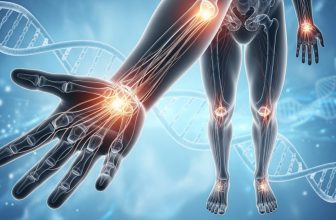
5 Science-Backed Genetic Insights That Help You Outsmart Dupuytren’s Disease (Even If It Runs in Your Family)
Introduction
Dupuytren’s contracture often runs deep in family lines due to genetics—sometimes stretching across several generations. Many patients recall seeing their parent or grandparent with bent fingers long before the condition appeared in their own hands. This strong hereditary influence doesn’t mean your future is fixed—it simply means awareness and early action can make all the difference.
1. Family Traits and Hidden Fibrosis Risks
Dupuytren’s has one of the highest hereditary tendencies among connective-tissue conditions. It is especially frequent in individuals with Northern European (Celtic or Nordic) ancestry, where certain gene variations affect how the body repairs tissue after injury. These variations can make fibroblasts—cells that produce collagen—overreact, leading to thickened cords and nodules under the skin.
Even so, environment matters as much as family background. Factors like smoking, diabetes, alcohol use, and nutrient deficiencies can “switch on” dormant fibrotic pathways.
2. What Science Has Revealed About Inherited Fibrosis
Major studies, including those published in Nature Genetics and Clinical Endocrinology, have pinpointed multiple regions of DNA that influence Dupuytren’s. Many of these regions are linked to the WNT and TGF-β pathways, which control how fibroblasts grow, move, and remodel tissue.
Interestingly, several of these same DNA patterns are also found in related conditions such as frozen shoulder, Ledderhose disease (in the feet), and Peyronie’s disease (in the penis). This overlap suggests a shared biological root—and a potential opportunity for future targeted therapies.
3. What a Family History Means for You
If one or more relatives had Dupuytren’s, your risk can be up to six times higher than average. You might notice nodules appearing earlier in life, or a faster progression once symptoms begin. However, this doesn’t mean the condition can’t be managed—it simply calls for more proactive care.
Genetic provide the blueprint, but lifestyle determines how that blueprint is read. Chronic inflammation, poor circulation, and oxidative stress—all influenced by daily habits—can activate these hidden cellular programs that cause tissue tightening.
4. Prevention and Early Intervention Work in Genetic
Even with a hereditary predisposition, you have power over how the condition unfolds. Adopting a lifestyle that minimizes inflammation and stabilizes metabolism can reduce risk.
Practical steps include:
-
Maintaining stable blood sugar levels.
-
Eating an anti-inflammatory diet rich in omega-3s and antioxidants.
-
Avoiding smoking and limiting alcohol intake.
-
Doing gentle hand stretches or massage to maintain mobility.
Those with strong family history should also perform monthly self-checks for nodules or skin thickening. Early detection dramatically improves treatment outcomes.
5. The Future: From DNA to Prevention
Researchers now describe Dupuytren’s as a polygenic condition—meaning several genes interact with environmental and metabolic triggers. Future testing may allow clinicians to identify high-risk individuals early and offer personalized prevention plans.
Until then, the best defense remains a combination of awareness, healthy lifestyle, and timely medical consultation. Treatments such as collagenase injections, needle aponeurotomy, or minimally invasive surgery work best when the condition is caught early.
Key Takeaways
-
Strong hereditary link: Family history increases risk five- to six-fold.
-
Ancestry factor: More prevalent among those of Northern European descent.
-
Multiple biological pathways: WNT and TGF-β signals drive fibroblast activation.
-
Lifestyle control: Healthy habits influence how inherited traits express.
-
Early detection matters: Regular hand checks can prevent severe contracture.
Join our Dupuytren’s community for shared experiences, treatment tips, and recovery stories:
👉 facebook.com/groups/dupuytrenssolutionsandhealth
Discover resources and patient journeys at dupuytrenssolutions.com.
Attribution:
(CC BY 4.0) Adapted from Dolmans GH et al. Common Variants in the Genetic Architecture of Dupuytren’s Disease. Nat Genet 2011;43(12):1248–1252.
Legal & Medical Disclaimer:
This content is for informational purposes only and not a substitute for medical advice, diagnosis, or treatment. Always consult your healthcare provider for professional guidance.






